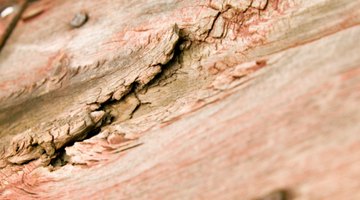How to Repair Rotten Wood Without Removal
Wood is vulnerable to moisture damage if not sealed or painted properly. Damage to window sills, window frames and door frames is especially common. When wood is rotten it becomes soft and no longer provides any structural support.

Things You Will Need
- Wood chisel
- Hammer
- Wire brush
- Drill
- 1/4-inch drill bit
- Liquid wood epoxy
- Squeeze bottle
- Paintbrush
- Wood epoxy
- Putty knife
- Disposable gloves
- Rasp
- 80-grit sandpaper
- 120-grit sandpaper
- Alkyd primer
If the damage is caught early enough, removing the rotten wood and using an epoxy filler strengthens the damaged area. Once the wood is repaired, take the necessary precautions to ensure more moisture cannot cause further damage.
-
Place a wood chisel near one end of the damaged area. Use a hammer to tap the chisel's back end and push it through the rotten wood, removing it. Continue hammering the chisel through until as much of the rotten wood as possible has been removed.
-
Rub a wire brush over the damaged area to remove any loose wood pieces. Drill shallow holes into the damaged area using a one-quarter-inch drill bit. Space the holes approximately 1 inch apart.
-
Mix a liquid wood epoxy according to the manufacturer's directions. Pour the liquid into a squeeze bottle. Apply the liquid to the damaged area and squeeze it into the holes you drilled in Step 2. Use a small paintbrush to spread the mixture over the damaged area's entire surface. Continue apply the liquid wood epoxy until the area is fully saturated.
-
Mix a wood epoxy according to the manufacturer's directions. Scoop a small amount of the mixture up with a putty knife. Use the putty knife to apply the mixture to the damaged area. Press the mixture firmly in place so it gets into all the gaps and adheres to the surface.
-
Use either the putty knife, a small strip of wood or your gloved fingers to smooth and shape the wood epoxy to closely match the damaged area's surrounding surface. It does not have to be perfect at this point. Allow the epoxy to dry for approximately 4 hours.
-
File down any ridges in the epoxy with a rasp or piece of 80-grit sandpaper. Try to get it to match the surrounding area as closely as possible. If you sand away too much epoxy, mix a little more following the manufacturer's directions and apply it.
-
Smooth out the repaired surface with 120-grit sandpaper. Use a paintbrush to apply a coat of alkyd primer to the epoxy and surrounding area. Allow the primer to fully dry before painting.
Tip
Wear disposable gloves when handling the liquid epoxy and wood epoxy.
References
Tips
- Wear disposable gloves when handling the liquid epoxy and wood epoxy.
Photo Credits
- Jupiterimages/liquidlibrary/Getty Images
- Jupiterimages/liquidlibrary/Getty Images
More Articles



